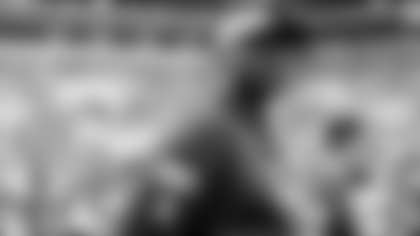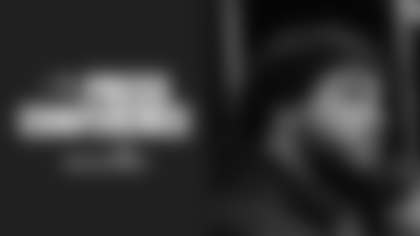The Bucs like the fact that Penn State CB Alan Zemaitis likes to bring the lumber
The Tampa Bay Buccaneers very nearly drafted Alan Zemaitis in the second round, with the 59th pick overall, before going with Boston College tackle Jeremy Trueblood instead.
Good move. The Penn State cornerback was still there in Round Four, at the 122nd pick, and the Bucs couldn't fill out their card fast enough. In Zemaitis, they get a big, physical, play-making defensive back who was almost universally scouted as a perfect fit for the Bucs' style of "Cover Two" defense.
So why was Zemaitis still on the board at 122 when many analysts predicted a second-round departure? It could have been the serious depth at the position this year, or the fact that he has to this point displayed merely good speed, rather than Combine-shaking 4.3s in the 40. It could be that he didn't attend the Combine, or the Senior Bowl. Or it could just be the way the draft fell, with teams choosing to fill other needs between 59 and 122.
Here's the bottom line: Tampa Bay coaches don't care. They coveted Zemaitis' secure tackling, good hands, game instincts and willingness to come up in run support, and they got all of that when they made the pick.
"We had him penciled in with the 27th pick of the second round if he was there as a corner," said Defensive Coordinator Monte Kiffin, who might now how a player fits into the Cover Two better than any man on the planet. "Now all of a sudden he's there in the fourth round. That happens every year. I don't go by if a player drops, I go by, 'What do we see?' We like this player. We really like him and I don't care if it's in the seventh round or the first round, we like the guy and we took him."
Zemaitis is about four inches taller Ronde Barber, but he has compared to the three-time Pro Bowler in the style of his play. That's a comparison that thrills Zemaitis, who will now have the opportunity to refine his game at Barber's side.
"I feel like I've got a lot of play-making ability, similar to Ronde at the NFL level," said Zemaitis. I feel like I'm just the kind of player that the Buccaneers would love – a guy who can hit, who has pride in what he's doing out there, who's willing to stay after to learn more and just be ready to compete. I think that I fit the mold of a Tampa Bay Buccaneer to a T."
Zemaitis might have been there for the Bucs because nobody ever slapped him with the coveted 'cover corner' tag. At Penn State, he played a lot of zone defenses (as, of course, do the Buccaneers). The same thing might have been said of Barber in 1997, as he left Virginia with 15 interceptions over a three-year span but still lasted until the third round, to the Buccaneers delight that year. Zemaitis was that type of playmaker in college, registering 12 interceptions over his three years as a starter, so the Bucs hope he can make the same sort of transition to the NFL.
"He's tough, he can tackle, he can play outside," said Kiffin. "He can play some nickel, like where Ronde plays when we move him inside. We love cover corners. We all love cover corners. We love guys that are fast and can cover, but they have to tackle, too. Because sometimes other teams run the ball. They turn to hand the ball off to Reggie Bush, and we need someone to tackle him."
**
What's in a Number?
In preparation for this weekend's mini-camp, the team has issued initial jersey numbers to each of the new players it drafted or signed over the last five days. After all, you can't practice without a jersey.
Of most interest are those numbers given to the players taken with the higher draft picks over the weekend, as history suggests they are the ones most likely to be seeing immediate action this fall. In addition, they are generally more well-known college players, and thus fans are paying attention to their debut numbers. The New Orleans Saints, for instance, are expected to petition to allow running back Reggie Bush to wear the #5 he sported at USC, even though that is not within the accepted range of numbers for his position.
Of course, the Saints can put Bush in #5 right now if they wish, as they would have until the first regular-season game to change it (at the core of that issue, of course, is the licensing of merchandise). And that's the point: These are first numbers given to each player, so take them with a grain of salt. At the moment, the Bucs' roster is crowded with nearly 100 players, meaning almost every jersey number is in play. Young players often receive one number now, then a more common one when and if they make the team, when the roster is thinned and more choices are available.
So what are the new Bucs wearing. First-round guard Davin Joseph will don #75 for this weekend's mini-camp, and his new linemate, second-round tackle Jeremy Trueblood, will be in #65.
The wide receiver position is particularly bloated at this time of the year, which is why third-rounder Maurice Stovall debuts in #17. Of course, Stovall could carry that number into the regular season (he wore #21 at Notre Dame), as the NFL changed its rule two years back to allow receivers to choose numbers in the teens. Prior to that, all receivers had to be in the 80s unless there were no numbers available in that range.
Fourth-round cornerback Alan Zemaitis landed a number that fits his position well: 29. The most prominent player in team history to wear that number to this point is Ricky Reynolds, a standout cornerback from 1987-93.
The rest of the 2006 draftees and their new numbers are as follows: DE/DT Julian Jenkins, 99; QB Bruce Gradkowski, 7; TE T.J. Williams, 85; CB Justin Phinisee, 35; DE Charles Bennett, 93; and TE Tim Massaquoi, 48. Once again, keep in mind that these numbers can change between now and the regular season, and some of them almost certainly will.
Click here for an up-to-date team roster.
The arrival of unrestricted free agent fullback Jerald Sowell last week also caused some shifting of numbers. Sowell, who wore #33 for a decade with the New York Jets, bargained with third-year running back Earnest Graham to get that number in Tampa. Graham agreed to bump up a spot, to #34. New back Andre Hall, an undrafted free agent out of USF, will start at #36.
**
Leftover Draft Notes
The 2006 NFL Draft is over and will soon fade into the background of mini-camps, free agent signings and, before you know it, training camp. Before we let it go, though, let's take a look at a handful of Buccaneer-related draft facts that you didn't even know you didn't know.
- Offensive line remains the Bucs most common draft-weekend option, by just a hair over their speedy cousins in the defensive backfield. The Bucs used their first two picks of the 2006 draft on O-linemen Davin Joseph and Jeremy Trueblood, the 54th and 55th players in that group ever drafted by the team. They then picked up two second-day defensive backs in Alan Zemaitis and Justin Phinisee, pushing that unit's draft-choice total to 54. Of course, as the Answer Man noted in a recent column, that type of analysis is taking the liberty of putting all types of offensive linemen into one group, which hardly seems fair to, say, tight ends. The most commonly drafted position by the Buccaneers per starting spot in the lineup, remains running back, even though the team didn't draft any this time around. * It's not terribly surprising to learn that quarterback Bruce Gradkowski is the first player out of Toledo ever drafted by the Buccaneers. In addition, however, Phinisee is the first Oregon player ever taken by Tampa Bay in the draft. * Another first for Gradkowski: He is the first quarterback the Bucs have ever taken in the sixth round of any draft. In fact, since the draft was shortened to eight rounds in 1993 and then seven rounds in 1994, the Bucs have almost never used second-day picks on passers. The only other quarterback the team has selected in Rounds 4-6 since 1993 is Joe Hamilton, grabbed in the seventh round in 2000. When the draft was still 12 rounds long, however, it was a fairly common practice, e.g. Mike Pawlawski (10th, 1992), Pat O'Hara (11th, 1991), Todd Hammel (12th, 1990), Mike Shula (12th, 1987), Steve Calabria (9th, 1984), etc. * Including their three this year, the Bucs have now made 10 seventh-round selections in the last three drafts, and 17 in the last six drafts. While it's true that seventh-rounders have, on average, a much lesser chance of making the team than a first, second or third-rounder, these picks are anything but useless. Several of those recent seventh-rounders have made the team, including CB Tim Wansley, WR Mark Jones, FB Rick Razzano, WR Paris Warren and WR J.R. Russell. Several others have gone on to play in the regular season for other teams, including DE Joe Tafoya, S Than Merrill, FB Casey Cramer and CB Lenny Williams. The more accomplished seventh-round picks in Buccaneer history include C Jim Pyne (1994), DT Curt Jarvis and DE/T Harry Swayne (1987), S Mike Prior (1985) and C Jim Leonard.






















